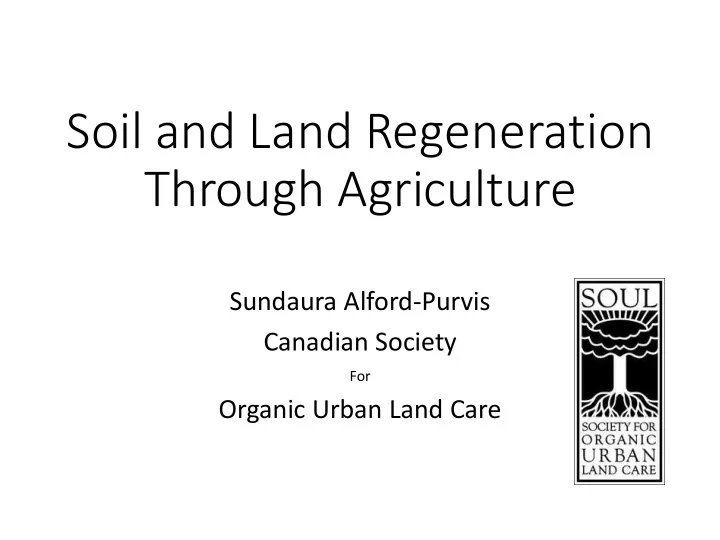

Soil and Land Regeneration Through Agriculture Sundaura Alford-Purvis Canadian Society For Organic Urban Land Care
Soil and Ecosystem Loss • In my lifetime: • The global biomass of wild mammals has fallen by 82%. • Natural ecosystems declined by 47% on average, relative to their earliest estimated states • Soil degradation and biodiversity loss are severe and accelerating • Farm profits are falling • Risks from severe weather events are increasing
Global Insect Populations Plummeting
Changing Weather is Leading to Declining Harvest
Increased Atmospheric Carbon is Causing Nutrient Density to Decline
Time for some Good News • There are some really interesting, inspiring, grass- roots things happening in food and agriculture and they don’t get much attention in media so we rarely get to hear about them. • Which is a bit strange, because they present real, viable solutions to some of the most daunting challenges we are dealing with at the moment, including food insecurity, ecosystem failure, biodiversity loss, urban flooding, and global heating.
Farmer Led Solutions
Solving Several Problems The same practices that restore soil carbon: • Reduce or reverse other ecological harms • Increase farm profits • Decrease sensitivity to extreme weather events, including droughts and flooding. • Increase biodiversity and support non-agricultural species (birds, pollinators, invertebrates, etc.)
How it it Work rks: 60 Seconds on the Soil il Carbon Cycle: • As plants grow, they capture atmospheric carbon dioxide, break the oxygen molecules off of the carbon, releasing them, and hold onto the carbon, either as liquid sugar (carbohydrate) or as part of their structural tissue. They also release a large percentage as root exudate into the soil to feed the biology there. Plants rely on soil biology for everything from nutrient and water transportation, through nitrogen fixation to defence against pests and diseases. • A portion of the carbon is metabolized, eventually making its way back into the atmosphere, and the remainder is sequestered in the soil in a stable form.
When Carbon is in the Soil it: • Improves soil resistance to erosion • Helps soil to hold water, without becoming waterlogged. (1% carbon increase in the top foot of soil = 1” more water that can be held in the soil) • Helps soil hold onto soluble nutrients • Provides habitat for biology that supports healthy plant growth All of which lead to increased ecosystem resilience and improved crop reliability and productivity.
Soil Carbon = Climate Solution • Global soils contain 2 to 3 times more carbon than the atmosphere and a huge amount of the atmospheric carbon cycles through plants and soils each year. If agricultural soil carbon level increased by 0.4%, or 4 ‰ per year, in the top 30 -40 cm of soil, annual sequestration would match global carbon emissions, as of 2015. https://www.4p1000.org/ • The excess carbon that we've dumped into the atmosphere can be sequestered in agricultural soils by plants and soil biology.
How are farmers working with plants to build soil carbon? • Minimizing soil disturbance, especially avoiding inverting the soil profile. (No Till) • Keeping soil covered with plant material throughout the year. (Cover Crops) • Mimicking the grazing cycles that plants evolved with by rotational or mob grazing. (This is what makes some beef carbon negative) • Minimizing or eliminating applications of concentrated materials that disturb soil biological function or accelerate the oxidization of humus
How are farmers working with plants to build soil carbon? • Planting perennial species, including trees, within agricultural systems. (Sylvaculture/Sylvapasture) • Growing a diverse blend of plant species • Cycling all organic waste back into the soil • Supporting / reintroducing soil biology through compost applications (https://www.marincarbonproject.org/) • Directly integrating animal agriculture into perennial and annual crop systems (https://www.savory.global/) • Trying, monitoring, adapting, adjusting, repeating
Not Singular. Not New. • No one solution can be applied to all systems, regions, ecosystems or food systems. Regenerative agriculture is less a set of activities than a set of outcomes. • This isn’t entirely, or even mostly, new, although technology is helping us understand, and hopefully better support, soil life. • Some of the change that has to happen is in how we think about ecosystems, moving from an extractive relationship to a reciprocal one.
So, what can you do? • Look for local foods produced by farmers using regenerative practices. • Purchase local, in-season foods. • Reduces transportation, especially refrigerated transport • Increases local food security • Grown to national safety and human rights standards • Reduces waste at the production and storage stages • If you have a garden, or any land that you work with, you can implement the same practices that are regenerating agricultural soils since most of them are scalable. (Maybe not the grazing…)
So, what can you do? • Try to use what you buy (research shows 30-50% Food waste in Canada) • Compost any organic matter that comes out of your garden or kitchen (vermicompost, bokashi bins etc.). • Spread the word – most people don’t know about living soils or that healthy soils can be a large part of the transition and mitigation that we need to deal with the effects of climate breakdown • Contact your elected representatives. (Why are wasting our organic matter? Why aren’t we investing in living green infrastructure? Why aren’t we valuing ecosystem services? Why aren’t we engaging farmers in carbon sequestration and flood mitigation?) • Sign the ‘Hold the line on urban sprawl’ petition
Learn about your ecosystem fr from the people who guided its creation • Indigenous knowledge, leadership and practices, with their millennia of ecosystem experience and understanding, will be critical to finding long term solutions.
A copy of this presentation, with active links to the resources referenced, can be downloaded from the SOUL website, in the resources section. www.organiclandcare.ca/presentations
Recommend
More recommend